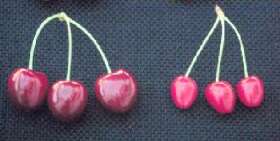|

German Version
Site map
FAIR 3889
Virus diseases
ACLSV
ApMV
ASGV
ASPV
PPV
PDV
PNRSV
ArMV
ToRSV
RpRSV
SLRSV
GFLV
GLRaV-1
GLRaV-3
LChV
CMLV
CRMV
CNRMV
CGRMV
ChTLV
CVA
Phytoplasma diseases
Pathogen collection
Pathogen detection
Pathogen elimination
Contact us
Related Sites
|
Little Cherry Virus
(LChV-1, LChV-2)
 The first case of little cherry disease (LCD) was recorded in 1933 in British
Columbia, Western Canada. The rapid spread in the area indicated an infectious
agent of a viral type, and transmission by an efficient arial vector. Indeed, it
is transmitted by the apple mealybugs, Phenococcus aceris.
The first case of little cherry disease (LCD) was recorded in 1933 in British
Columbia, Western Canada. The rapid spread in the area indicated an infectious
agent of a viral type, and transmission by an efficient arial vector. Indeed, it
is transmitted by the apple mealybugs, Phenococcus aceris.
The symptoms resemble those of phytoplasmoses, and particularly peach X disease
on cherry. On part or the entire deficient-looking tree, cherries do not
grow normal size, mature late, leaves become chlorotic and reddish in summer.
Only cherries are susceptible to the disease. In contaminated areas, wild and
ornamental cherries like P. emarginata or P. serrulata can be
latently infected.
In 1996, a closterovirus associated with a german isolate of LCD was identified and
named LChV. Its complete sequence was determined in 1997. However, there exist
different viral strains, LChV-1 and LChV-2, where strain 2 appears to be the
virus previously identified to be associated with LCD in Canada.
Little cherry diseases have been observed in Germany, Belgium, UK, the Netherlands
and Switzerland, but their relation to the american disease is not known. It has
neither been reported from Spain, Italy or France, indicating a certain
confinement to northern regions.
|



